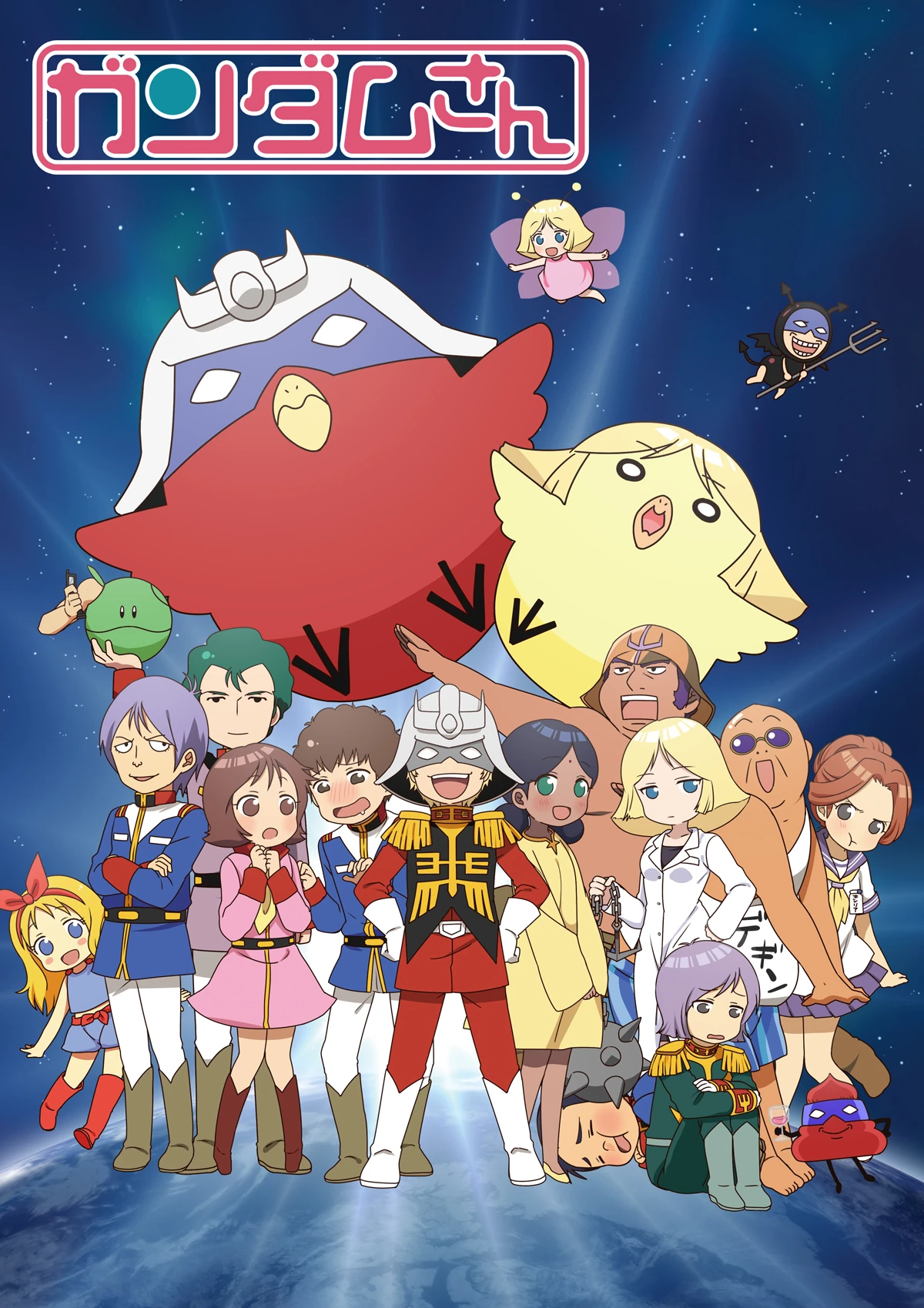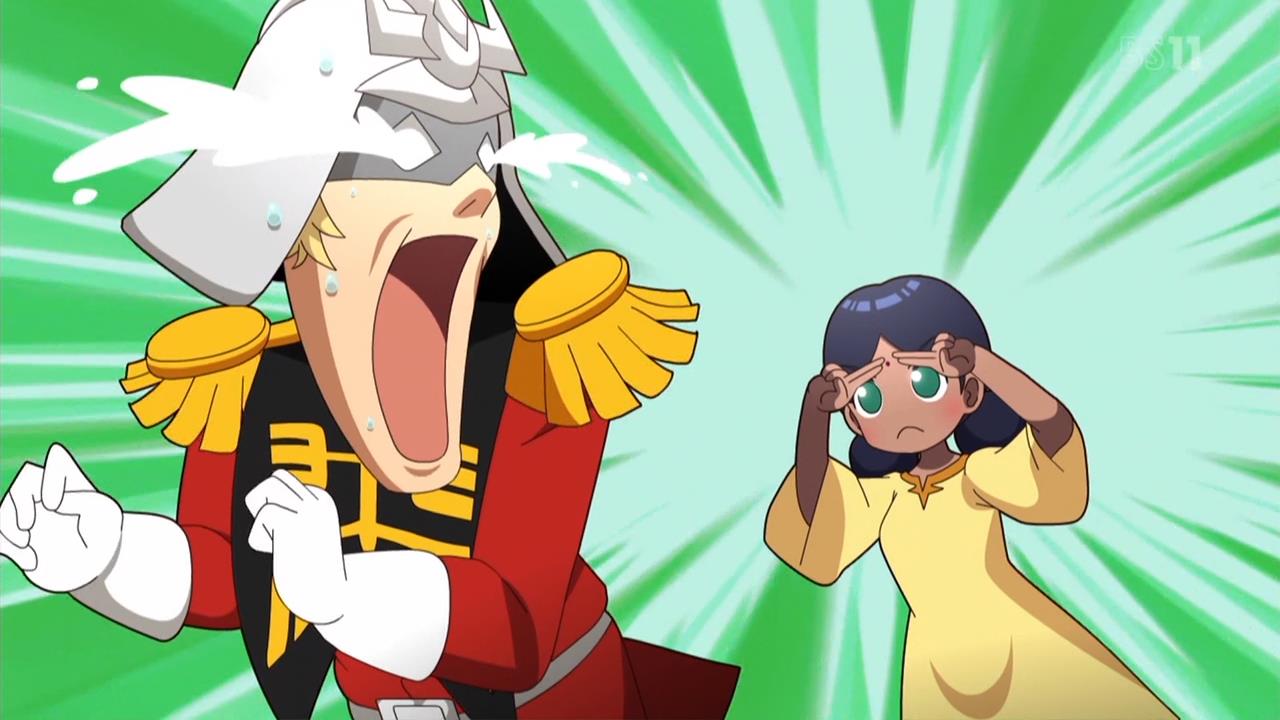Director: Mankyū
Screenplay: Hideki Ohwada and
Mankyū
Based on the parody manga by Hideki
Ohwada
Voice Cast: Katsuyuki Konishi as
Char-san/Suisei Hiyoko; Megumi Han as Lalah-san; Tsubasa Yonaga as Amuro-san;
Kaori Nazuka as Artepiyo/Sayla-san; Kazuyuki Okitsu as Garma-san; Keiko Han as
Proverb explanations; Rikako Yamaguchi as Fraw-san; Ryotaro Okiayu as
Bright-san
Viewed in Japanese with English Subtitles
I promise I'll actually review a
true Gundam series, as yes, it's
ridiculous that I have yet to see any of the main titles of this legendary
franchise started with Mobile Suit
Gundam (1979-1980). (No, Gundam
Reconguista in G (2014) doesn't qualify even if I have fondness for its
scatterbrained weirdness, because if any show really shouldn't be recommended
as your first Gundam as it was for
me, that's it). For the third, I promise, to watch an actual series in the main
franchise or alternative world versions, be it the original, Seed, Destiny, maybe be wary of OO
and its divisive sequel, maybe Wing
as a breakout mainstream success, definitely not G Gundam as whilst I want to see it, a strange decision to turn a
show about war and politics into giant robot tournament fights with humour is
not connected to the franchise's main premises.
Until then, Char Aznableas
interpreted as an evil red chick wearing a little helmet.
Because if anything, parodies of
original properties which are officially sanctioned is a common concept in
anime and manga, and a great way for an outsider like myself to be slowly
introduced into these shows. Even if half the jokes here only really make sense
to a fan, like the character of Garma Zabi who is clearly infamous for a series
of misfortunate events to himself, if I can still see this officially
commissioned piss take based on a four panel manga and find stuff of interest,
I can now see the original serious work's significance in popularity, get a
taste of it and now want to see the show both because of this and in happiness
the Gundam creators at Sunrise have a sense of humour.
Parodies are their own cottage
industry, even in the midst of a production of a sereis a chance of a short
comedy micro-series to be created for the physical releases as a bonus,
something I have come to love when they actually exist just for seeing the
voice cast and production unwind and subvert their material. Neon Genesis Evangelion (1995) had a
radio drama Evangelion: After the End
(1996) where Megumi Hayashibara,
who played the meek character Rei, got to play her as a motor mouth slapping
cast members and creator Hideaki Anno
himself as an evil villain. Fist of the
North Star (1983-8) and its 1984-7 TV series, the influential manga that
inspired the likes of JoJo's Bizarre
Adventure, is as sustained as much now by DD Fist of the North Star (2013) (about the cast of post apocalypse
muscle men if the nuclear apocalypse didn't happen and they had to find work)
as much as tie-in and remakes. Manga even has "omake", side pieces
which might not always be directly about the work, or even a parody, but can
have light hearted, and even have the creators both talk about their work and
be playful about their persona, be it horror author Junji Ito for Uzumaki
depict himself as going almost crazed researching the power of the spiral, or
in Miyuki-chan in Wonderland (1993-5),
the whole of the four woman manga team CLAMP
to admit they drew that manga just because they wanted to see questionable girl
on girl titillation.
Gundam-San, as a licensed product by the creators of Gundam, also can get away with being profane.
I know, even having never seen Gundam
yet, the importance of a character like Char, the famous antagonist who wears
red and never takes off an iconic helmet that obscures his face. The first
episode takes a scorched earth policy to this image, in less than three
minutes, with a) Char being an idiots who gleefully likes being nude, and b)
having his female second-in-command Lalah Sun (who is by all accounts much meeker
in the original series) devastate him when she informs him painting his giant
robot red doesn't make it go faster. It's completely hilarious even if I have
no context for either character in their importance to the fanbase.
Gundan-San is slight, I'll be upfront with it, but if they ever
bankrolled a longer series, I'd be there to watch it with interest because
these versions of the characters can be played with for many possibilities.
Char is useless, Lalah much more reliable. The male protagonist of the original
Amuro Ray, the stereotypical plucky teenage hero, is a gleeful mocking of
teenage hormones as awkwardly portrayed as possible, especially as he is a
psychic (a "Newtype" in Gundam
lore) which allows him to notice if someone's bra is unhooked. Likewise the
female protagonist Sayla Mass gets to confess to a sadistic side to enjoying
slapping people about, part of a funny traditional of gentle or/and stoic
female characters getting to be played by voice actresses in bawdy, crude or
even comically violent ways. Probably the best episode, number three, informs
us the robot mascot Haro has actual flesh arms inside itself who also, on the
phone when not seen, is a working guy with a family and issues with if wife, as
if say Star Wars had R2D2 had to go
off to the side and deal with his wife leaving him over a mobile phone between
space battles.
Then there's chicken Char, which
envisions Char as a red feathered chick with the exact same helmet. The closest
thing to a narrative in the thirteen episodes is the ongoing struggle between
Char and chicken Char, who are trying to off each other behind Lalah's back. I
think my one disappointment with Gundam-San
is that this semblance of a plot could've been taken to another funnier climatic
punch line and ended the series on a high note, just instead abruptly ending
with the last episode just being about Char presuming the mole on Lalah's head allowing
her to psychically shot lasers out of it. Obviously, this is extra material for
a fuller work, so the slightness is to be expected, but that running gag
would've paid off if ran for at least one more episode.
What you get, like many of these
parodies, is a more relaxed and playful attitude to animation too, as they play
up to the greater limitations of it for humour.
I swear, when the titular Gundam robots appear, they're actual models.
These type of pastiches are a way to have fun, and if anything even a novice on
this subject has to be impressed that the end theme, a traditional Japanese
sing-along, has three versions to reflect Char, Amuro and Garma, that hapless
guy whose episode is entirely about Char being a dick tormenting him. The
playfulness comes from an institution, so even those songs have a refrain to
shout aloud the three's famous lines to play this up for a sense of amusement
among fans. It even mocks some details that might be unintentionally funny from
the main series, such as leader of Amuro's ship Bright Noa clearly liked to
slap crew around, as an episode is based around him going to consoling about this
fact and sharing a similar bond with Sayla.
The crassness, from the sex gags
to the end credits even having Amuro nude tied up on a gym horse in red bondage
ropes and a S&M gag, is felt with a healthiness to it rather than being tasteless,
in allowing a series to become stronger by commissioning a sacred cow to be
mocked officially. And it's consistently funny, so Gundam-San at least got right what it was meant to do. Even if it's an odd choice to have made for
myself in seeing this as one of the first Gundam
properties, it does show promise when the official parody is as enticing to
the main material as it is. Whilst there are probably equivalents in Western
pop culture, this is definitely a concept very prevalent in Japanese anime and
manga for the better, something heart warming to the fact its encouraged for
production star and talent to let their hair down and do something as
ridiculous as this from time to time.



No comments:
Post a Comment